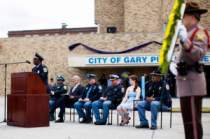Fifty years ago, the population of Gary, Indiana reached its peak with nearly 180,000 residents. Infrastructure was being built on estimates that the area may soon be home to nearly a quarter million people. Founded around the turn of the century and designated as  the home of the Gary Works steel plant, soon automation replaced human labor and demand for domestically produced steel decreased. As the number of employees of Gary Works declined, so did the economy and tax base of the city, as well as its population, which now hosts less than 80,000 residents. During that time, another legal phenomenon swept the nation, which only contributed to Gary’s woes. The United States experienced the proliferation of the war on drugs. These two factors led to Gary experiencing high crime and poverty rates, which continue to affect the city that resembles a ghost town more each year.
the home of the Gary Works steel plant, soon automation replaced human labor and demand for domestically produced steel decreased. As the number of employees of Gary Works declined, so did the economy and tax base of the city, as well as its population, which now hosts less than 80,000 residents. During that time, another legal phenomenon swept the nation, which only contributed to Gary’s woes. The United States experienced the proliferation of the war on drugs. These two factors led to Gary experiencing high crime and poverty rates, which continue to affect the city that resembles a ghost town more each year.
The failure of central planning has also negatively impacted the city. City hall grossly overestimates property values in an attempt to recoup the tax base lost to other towns and cities as residents fled. While houses and businesses sit abandoned and in shambles, back  taxes are claimed owed on them despite their negative value. Travelling through the city full of crumbling structures, it would seem the obvious solution would be to allow the impoverished residents to homestead and reclaim the land and property which is underutilized. Yet police in Gary still work to combat squatting in structures deemed to have potential future value, if only someone would purchase and refurbish them.
taxes are claimed owed on them despite their negative value. Travelling through the city full of crumbling structures, it would seem the obvious solution would be to allow the impoverished residents to homestead and reclaim the land and property which is underutilized. Yet police in Gary still work to combat squatting in structures deemed to have potential future value, if only someone would purchase and refurbish them.
The most prominent, lit-up, and welcoming businesses aligning Gary’s downtown are payday loan stores, which are a sad sign of the financial desperation of the city’s inhabitants. With many crimes, including robbery, burglary, rape, and homicide being off the charts compared to Indiana as well as national averages, one would hope that the police in Gary would become focused on addressing the major problem of violent crime. But where are priorities at the Gary police department?
Since the 1960s, Lake County, Indiana, where Gary sits, has been considered a hotbed of corruption. Despite the city’s small and shrinking size, all of the elements of big city corruption and bureaucracy are present. There are numerous cases of gross police  misconduct and involvement in criminal activity and brutality, including assaults on handcuffed suspects, participation in cocaine distribution, cannabis trafficking, kidnapping and strangulation, and also robbery and murder executed under the guise of drug raids. In 2008, former chief Thomas Houston was convicted in a federal court of abusing confined suspects. Akin to a big city, nobody steps up to take charge and responsibility, as even the current chief of police has requested officers be fired for abusing authority while a Civil Service Commission is permitted shift the blame and pass the buck.
misconduct and involvement in criminal activity and brutality, including assaults on handcuffed suspects, participation in cocaine distribution, cannabis trafficking, kidnapping and strangulation, and also robbery and murder executed under the guise of drug raids. In 2008, former chief Thomas Houston was convicted in a federal court of abusing confined suspects. Akin to a big city, nobody steps up to take charge and responsibility, as even the current chief of police has requested officers be fired for abusing authority while a Civil Service Commission is permitted shift the blame and pass the buck.
When being interviewed about Gary’s homicide problem earlier this year, chief Wade Ingram points out that while there has been a net decrease in shootings in the city of recent, that more of the shootings are resulting in fatalities, which means more intentional execution of victims, usually with multiple gunshots. Ideally, victimless crimes should be set aside, and the shocking murder and violence rate should be the focus of the police. Desperate for assistance, the chief cites a search for federal grants, but in what areas will this outside assistance be applied?
If [the governor] can’t send manpower, we would like the be the recipient of some type of grants that would assist us with fighting crime, whether it’s enforce seat belt missions, or any type of traffic enforcement, so that’s what we’re trying to do.
To divert the topic of disturbing murder rates to the issue of seat belt and vehicular traffic enforcement demonstrates just how out of touch police are with the real issues plaguing the community. It is understandable that no one would want to be a homicide detective, or be actively present during a situation where shots may be fired, but who will actually step up to work on the real problems? The incentive is for each individual employed by the city to maintain as safe and comfortable a position as possible, and often that means only responding after gunshots have subsided, and not getting to know the individuals most affected by the violence, since their lifestyles may be such that would send them to prison or bring about their fate for merely interacting with police.
Wade Ingram, sworn in as chief in early 2012, subscribes to the Broken Windows theory of enforcement (not to be confused with the Broken Windows fallacy). The theory posits that lower level, quality of life crimes should be promptly addressed in an attempt to prevent the proliferation of such offenses. As there is no shortage of actual broken windows in Gary, there is no time to address every such lower level offense in such a location. While the  broken windows theory provides a model to prevent specific areas from reaching disrepair, in an area where serious crime is already an issue, harassing young people for loitering, playing loud music, or having open containers of alcohol is literally turning a blind eye to larger issues. Every time that the police expend their scarce resources searching for drugs at traffic stops or making open container arrests is time not spent searching for the culprits in robbery and homicide cases continually growing cold. The theory may also perpetuate the idea among enforcers that all crime should be treated equally, equating the graffiti vandal with the murderer since they are all deemed part of a larger crime problem.
broken windows theory provides a model to prevent specific areas from reaching disrepair, in an area where serious crime is already an issue, harassing young people for loitering, playing loud music, or having open containers of alcohol is literally turning a blind eye to larger issues. Every time that the police expend their scarce resources searching for drugs at traffic stops or making open container arrests is time not spent searching for the culprits in robbery and homicide cases continually growing cold. The theory may also perpetuate the idea among enforcers that all crime should be treated equally, equating the graffiti vandal with the murderer since they are all deemed part of a larger crime problem.
On the ground in Gary, we met inhabitants who spoke of losing friends to senseless violence, whether that meant their death in the street or their incarceration for victimless crimes. Many of the homicide victims in the city are males aged sixteen to twenty-five. There was expressed much suspicion and fear of the police, who individuals believed for good reason also have a hand in Gary’s drug trade.
In expressing dependence and expectation that assistance will come from outside of the community, it is doubtful that the current bureaucracy is in any position to address the needs of the community. While technology and automation is often blamed for the economic depression of the area, there is hope that technology that is decentralized and  individually empowering can revitalize the neighborhoods that have become locked down. Filming of the police is not a common practice in Gary, so it was very inspiring to tour the city with the crew of Northwest Indiana CopBlock and document the actions of police employees. As inhabitants observed groups of people marching towards authorities with rolling cameras, confusion became support for the practice. Police employees often took notice of cameramen, observing and pointing the situation out to their colleagues. What was once not common may become the norm. In addition to domesticating the heavy-handed among the department, may the accountability inspire the few within who do care about community safety to focus on the problems associated with real crime and disregard enforcement of legislation which only perpetuates the city’s social woes.
individually empowering can revitalize the neighborhoods that have become locked down. Filming of the police is not a common practice in Gary, so it was very inspiring to tour the city with the crew of Northwest Indiana CopBlock and document the actions of police employees. As inhabitants observed groups of people marching towards authorities with rolling cameras, confusion became support for the practice. Police employees often took notice of cameramen, observing and pointing the situation out to their colleagues. What was once not common may become the norm. In addition to domesticating the heavy-handed among the department, may the accountability inspire the few within who do care about community safety to focus on the problems associated with real crime and disregard enforcement of legislation which only perpetuates the city’s social woes.
For more, check out the short video Who is addressing Gary’s murder problem? produced by Garret Ean for the 2013 Police Accountability Tour.


